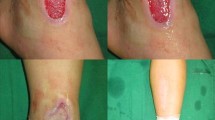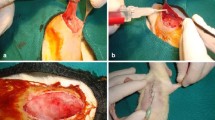Summary
Human fibrin glue (Tissucol) is a plasma-derived compound endowed with adhesive and hemostatic properties and possessing a specific local anti-infection function mediated through activation of nonspecific immunity elements. The aim of this study is to show that in patients who have undergone prolonged reconstructive plastic surgery following cancer resection, Tissucol decreases infectious complications as compared to a control group. Between June 1985 and February 1988, 51 subjects were treated with fibrin glue during reconstruction operations. Analysis of the results showed that Tissucol produced a statistically significant reduction both of immediate complications, such as inflammation and partial separation of the surgical wound, and of delayed complications, such as scar hypertrophy and cutaneous fistulae. In conclusion, patients treated with Tissucol showed a better quality of surgical wound, a more rapid postoperative functional recovery and consequently a decrease in the duration of hospitalization.
Similar content being viewed by others
References
Aach RD, Szmuness W, Mosley JW et al (1981) Serum alanine aminotransferase of donors in relation to the risk of non-A, non-B hepatitis in recipients. N Engl J Med 304:989
Bosch P (1980) Experimental investigation of the effect of fibrin adhesive graft. Arch Orthop Trauma Surg 96:177
Brandstetdt S, Rank F, Olson PS (1980) Wound healing and formation of granulation tissue in normal and defibrinogenated rabbits. An experimental model and histological study. Eur Sur Res 12:12
Bruster HT, Juntz BME, Scheja JW (1988) Autovaccination plus heat-inactivated autologous plasma in AIDS patients. Lancet 1:1284
Cronkite EP, Lozner EL, Deaver JM (1944) Use of thrombin and fibrinogen in skin grafting. J Am Med Assoc 124:976
Donati L (1986) Indicazioni e limiti della colla di fibrina (Tissucol) in chirurgia plastica. Proceedings of the XXXV Conference of the Italian Society of Plastic Surgery; Milan, September 25–27, 1986. In: La colla di fibrina (Tissucol) in chirurgia plastica. Monduzzi, Milan, p 51
Eder G, Neumann M, Cerwenka R, Baumgarten K (1986) Preliminary results of a randomized controlled study on the risk of hepatitis transmission of a two-component fibrin sealant (Tissucol/Tisseel). In: Schlag G, Redl H (eds) Fibrin sealant in operative medicine. Springer, Berlin, 7:51
Germani G (1982) Utilizzazione della colla di fibrina in chirurgia plastica. Riv It Chir Plast 1:443
Hedelin H, Lundholm K, Teger-Nilsson AC et al (1983) Influence of local fibrin deposition on granulation tissue formation. A biochemical study in the rat. Eur Surg Res 15:312
Hornbrook MC, Dood RY, Jacobs P et al (1982) Reducing the incidence of non-A, non-B post-transfusion hepatitis by testing donor blood for alanine aminotransferase. N Engl J Med 307:1315
Hunt TK, Knighton DR, Thakral KK et al (1984) Studies on inflammation and wound healing: angiogenesis and collagen synthesis stimulated in vivo by resident and activated wound macrophages. Surgery 86:48
Kasai S, Kunimoto R, Nitta K (1983) Cross-linking of fibrin by activated factor XIII stimulates attachment, morphological changes and proliferation of fibroblast. Biomed Res 4:155
Matras H (1982) The use of fibrin sealant in oral and maxillofacial surgery. J Oral Maxillofac Surg 40:617
Rousou J, Gonzales-Lavin J, Cosgrove D et al (1989) Randomized clinical trial of fibrin sealant in patients undergoing resternotomy or reoperation after cardiac operations. J Thorac Cardiovasc Surg 97:194
Schricker KT, Scheele J (1981) Hepatitisrisiko der Fibrinklebung in der Allgemeinchirurgie. Med Welt 32:783
Spangler HP (1976) Tissue adhesion and local hemostasis fibrinogen, thrombin and clotting factor XIII (experimental investigation-clinical experience). Wien Klin Wochenschr 88 [Suppl 49]:3
Staindl O (1982) The fibrin-adhesive system in plastic surgery of head and neck. J Head Neck Pathol 3:78
Staindl O (1979) The healing of wounds and scar formation under the influence of a tissue adhesion system with fibrinogen, thrombin and coagulation factor XIII. Arch Otorhinolaryngol 222:241
Author information
Authors and Affiliations
Rights and permissions
About this article
Cite this article
Fabrizio, T., Nava, M., Arioli, N. et al. Usefulness of fibrin glue in oncologic plastic surgery. Eur J Plast Surg 13, 201–205 (1990). https://doi.org/10.1007/BF00634569
Issue Date:
DOI: https://doi.org/10.1007/BF00634569




